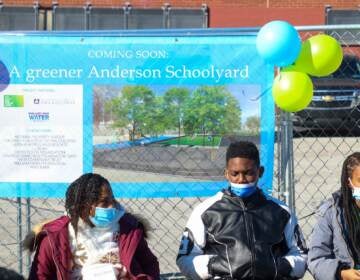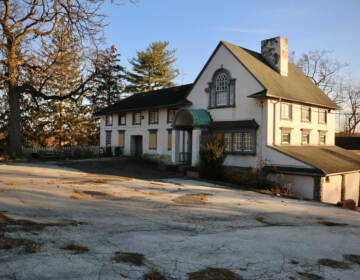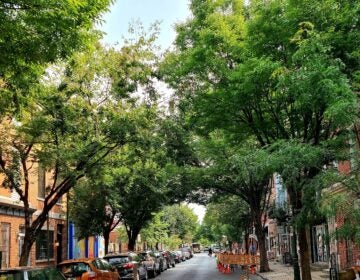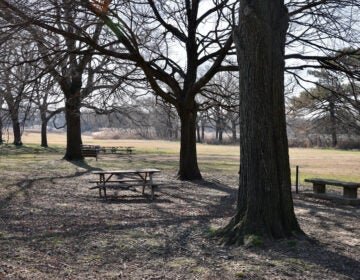Alarms raised after hundreds of trees removed from city-owned Cobbs Creek Golf Course
A nonprofit promises to restore the public golf course to its historic design, but park users and flood advocates are crying foul over the removal of trees.
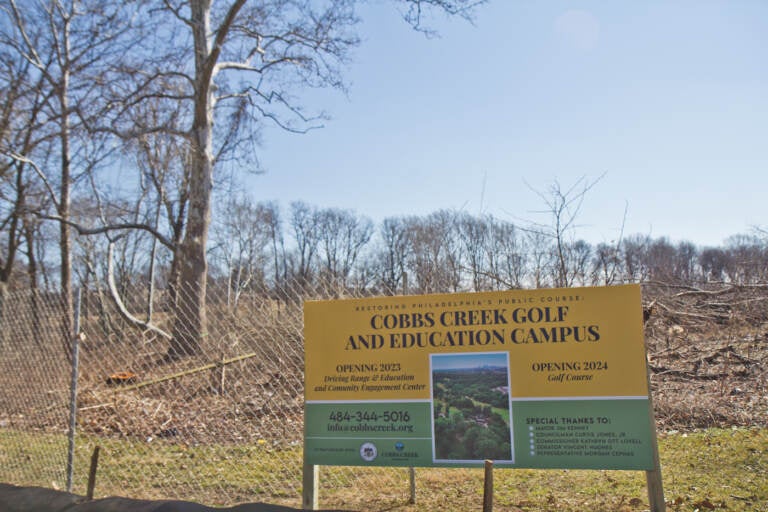
File photo: Many trees were felled as part of the restoration and renovation of the Cobbs Creek golf course and community engagement center, as seen on Feb. 27, 2022. (Kimberly Paynter/WHYY)
Dead tree trunks, some dozens of feet long, littered parts of the Cobbs Creek Golf Course on the western edge of the city on Sunday. Stumps — some as large as four feet wide — dotted the hilly landscape.
Neighbors, park users, and environmental advocates are raising the alarm about the removal of hundreds of trees by the private foundation that’s leasing the land from the city to renovate it into a PGA event-ready public golf course.
“I was heartbroken,” said Bari Turner, a nearby homeowner in the Overbrook section, who described a scene of total devastation after visiting the site last week. “Tears literally came to my eyes.”
The city has approved permits for the Cobbs Creek Foundation to clear “some, but not all” trees from a quarter — or close to 90 acres — of the 350-acre property, said Philadelphia Parks & Recreation spokesperson Maita Soukup. Two permits to remove additional trees from some steep slopes on the property are pending a Zoning Board of Appeals hearing. As of Sunday, nearly all trees had been cut down between Indian Creek, Cardington Road, and a section of Cobbs Creek near the center of the property, many right along the waterways.
The 30-year, renewable lease agreement the city finalized with the Cobbs Creek Foundation in December aims to expand and improve golfing opportunities at the course, which closed in 2020 over safety concerns, after erosion and flooding damaged its greens and fairways, and a 2016 fire destroyed the course’s historic clubhouse. A new nine-hole course, short course, and 18-hole championship course capable of hosting PGA Tour events are expected to open to the public at Cobbs Creek in 2024. The Foundation plans to restore the course to its 1916 design.
To do this, the Foundation must remove “several hundred trees” to reconfigure the course, according to the lease agreement. Michael Rodriguez of Ceisler Media & Issue Advocacy, who is handling public relations for the Foundation, said in an email that much of the vegetation throughout the property is of “poor ecological value,” entangled in invasive shrubs and vines, or being undercut by eroding stream banks. The Foundation did not accommodate PlanPhilly’s request for an interview.
“All efforts are being made to leave high-quality vegetation intact and avoid tree clearing unless necessary,” Rodriguez wrote.
But the removal of so many trees seems to run counter to the city’s own goals. The Philly Tree Plan the Parks Department is currently finalizing aims to increase tree cover in the city from roughly 20% to 30% within 30 years, and is expected to recommend stronger requirements for developers around tree replacement. Asked whether officials in the Parks Department agree with the Foundation’s assessment of the trees it cut down at the Cobbs Creek Golf Course, Soukup echoed the Foundation’s points.

But local naturalists and park users disagree. Many of the trees cut were mature native species, including tulip poplars, American sycamores, oaks, and sugar maples, said production arborist George Pushkal, a member of the Philadelphia Mycology Club who visited the site last week.
“It seemed like a lot of the trees that they were cutting down were [for] more like aesthetic reasons,” he said. “Having worked at golf courses myself … they love single-standing trees, like specimen trees or whatever, they love just leaving that and then clear-cutting everything else around it.”
Neighbors and park users say the overgrown course, which borders Haddington Woods, was home to a wide variety of plants and animals, including foxes, dozens of species of birds, edible plants like spicebush and black cherries that tasted “just like candy,” and huge hen-of-the-woods mushrooms.
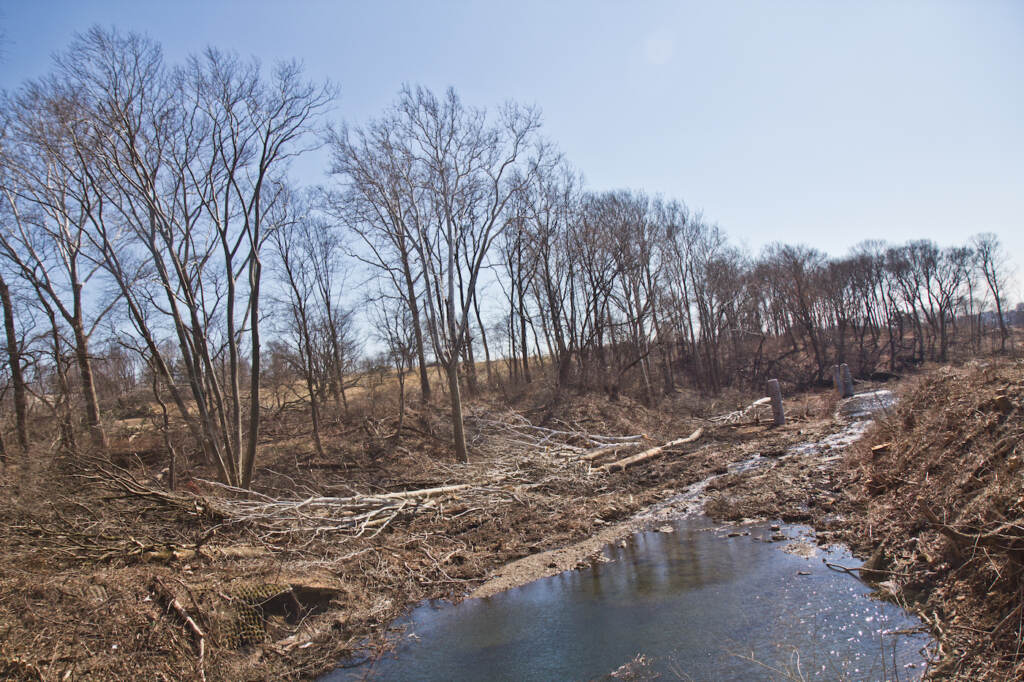
“The Cobbs Creek Golf Course is actually just about as biodiverse as the [John Heinz National] Wildlife Refuge,” said Ro Maurer, a Cobbs Creek resident and frequent user of the park with the Cobbs Creek Ambassadors, which organizes cleanups of the park, the Wild Foodies of Philly and the mycology club. “It was like a living classroom back there that was free and open to the public.”
Concerns about flooding
The golf course is already flood-prone, and part of the Foundation’s plan is to “restore and rebuild” over three miles of Cobbs Creek and its tributaries by removing invasive vegetation, creating up to 37 acres of wetland including 10 square miles of drainage areas, and removing sediment from the creek beds.
“The project areas would be permanently protected and would develop into a mature forested buffer with substantially higher quality vegetation than the site currently supports,” Rodriguez wrote on behalf of the Foundation.
But Rodriguez did not provide any modeling or analysis showing that the plan will reduce flooding impacts to nearby communities. The removal of trees along the Indian and Cobbs creeks concerns Josh Lippert, former floodplain manager for the city of Philadelphia.
“Any sort of tree removal has negative ramifications for the environment, specifically for stormwater runoff,” Lippert said. “Trees have extremely beneficial practices in floodplains. They can stop erosion and scour of streambanks of adjacent lands. The removal of those is definitely detrimental.”

Lippert worries the project could mean problems for residents downstream in the already flood-prone Eastwick neighborhood, where Cobbs Creek meets Darby Creek. He said he has unanswered questions about how the clear-cut trees will be replaced, and sees the project as a missed opportunity to use public land to its full flood-mitigating potential.
“My problem with this specific project is it’s city-owned land,” he said. “So as a city, we should want to do more for our residents that are suffering impacts of flooding downstream.”
Community leaders in Eastwick were not made aware of the project or its potential impacts on flooding — good or bad. Carolyn Moseley, executive director of the Eastwick United Community Development Association and the visionary behind a bold idea to reduce flood risk to her neighbors, wants to speak with the people behind the golf course renovation, and hopes residents can redirect the development plans if needed.
“I would like to see perhaps some sort of a coalition or a collaborative between all of the communities along that watershed so that we could have meaningful discussions about what developments are taking place in our respective areas and … the potential impacts on other communities,” she said.
Outrage over lack of community input
To Lippert and others, the tree removal at the Cobbs Creek Golf Course is a story of environmental injustice, in a ZIP code where more than 80% of residents are Black.
Turner, the homeowner in Overbrook, noted neighborhoods with more residents of color tend to deal with more dangerous summer heat, in part because of low tree cover. But residents near the Cobbs Creek course used the space to heal, relax and reconnect to the natural world, Maurer said.
“The demographics of people using that green space very closely mirrored the demographic of the Philadelphia area, which is amazing to see, as a Black person who is into the outdoors,” Maurer said.
The Foundation frames its work as continuing the inclusive legacy of the historic golf course — which welcomed players of color decades before other courses and the PGA. The Foundation’s revitalization plan includes a new education and community engagement center, as well as the promise of partnerships with area school districts to provide career skills programs and other opportunities “for the diverse youth of Philadelphia.” Soukup, with the Parks department, said the work currently underway at the course represents years of advocacy from the Overbrook community.

But golf is the last thing on many neighbors’ minds, said Overbrook resident Raymond McKenzie. If the Foundation really wanted to help nearby residents of color, it should have worked on bringing another grocery store or pharmacy to the neighborhood, he said.
“It’s not right,” McKenzie said. “There was next to no communication.”
Members of the Foundation have met with elected officials, educators, and faith leaders, and presented the site preparation plans — including tree cutting — to the Overbrook Park Civic Association, Rodriguez said. But neighbors including Turner had no idea.
“[The tree removal] took me by surprise, and I found myself asking the question, how could we have let something like this happen?” she said. “Did I not see a memo? Did I not listen to the voicemail message that may have been left, letting us know that there was going to be some type of meeting to discuss what the plans were for this area?”
The Cobbs Creek Ambassadors are encouraging members of the public to write to Philadelphia Parks & Recreation Commissioner Kathryn Ott Lovell and 4th district City Councilmember Curtis Jones, Jr. to demand the city immediately end tree cutting at the golf course and hold “honest and transparent” community meetings to discuss the future of the public land.
“Our goal is to try to pressure Parks and Rec to listen to what the needs of the community are and … just make sure that we have this resource,” Maurer said.

Subscribe to PlanPhilly
WHYY is your source for fact-based, in-depth journalism and information. As a nonprofit organization, we rely on financial support from readers like you. Please give today.




